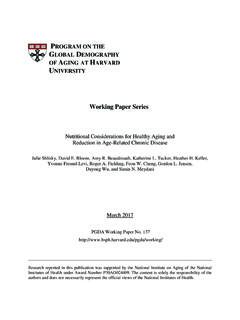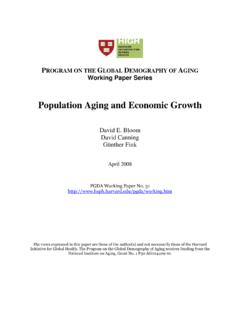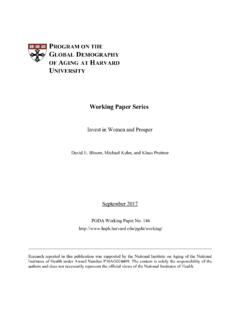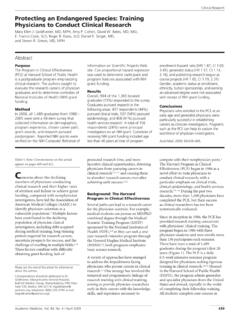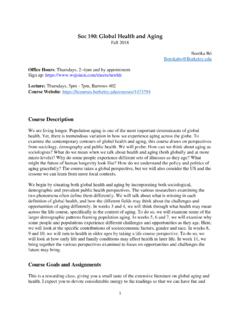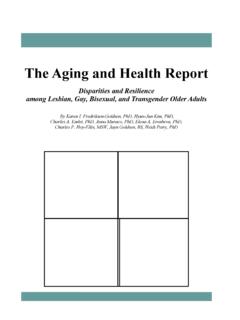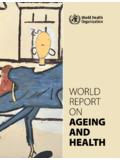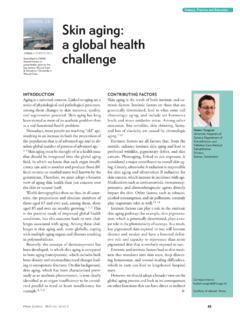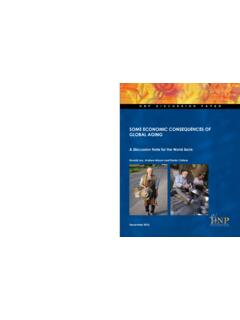Transcription of Program on the Global Demography of Aging
1 HARVARD INITIATIVE FOR Global health WORKING PAPER SERIES Program on the Global Demography of Aging Global DEMOGRAPHIC CHANGE: DIMENSIONS AND ECONOMIC SIGNIFICANCE David E. Bloom, David Canning Harvard School of Public health Working Paper No. 1 April 2005 The views expressed in this paper are those of the author(s) and not necessarily those of the Harvard Initiative for Global health . The Program on the Global Demography of Aging receives funding from the National Institute on Aging , Grant No. 1 P30 AG024409-01. 2005 by David E. Bloom and David Canning. All rights reserved. 2 ABSTRACT1 The last 150 years have been a period of unusual demographic change. Baby booms occurred in the aftermath of wars in some countries.
2 In others, baby booms occurred as a result of falling infant mortality rates and subsequent reductions in fertility. Baby boom generations produce an echo, in the form of a large cohort of children a generation later, creating long-term demographic disequilibria. These destabilized age structures, together with improvements in health and longevity among the elderly, are producing, for the first time in history, populations with large and growing rates of old age dependency. We argue that transitions from high mortality and fertility to low mortality and fertility can be beneficial to economies as the large baby boom cohorts enter the workforce and save for retirement, while rising longevity has perhaps increased both the incentive to invest in education and to save for retirement.
3 We present estimates of a model of economic growth that highlights the positive effects of demographic change during 1960-95. We also show how Ireland benefited from lower fertility in the form of higher labor supply per capita and how Taiwan benefited through increased savings rates. We emphasize, however, that the realization of the potential benefits associated with the demographic transition appears to be dependent on institutions and policies, requiring the productive employment of the potential workers and savings the transition generates. Population Aging is a new phenomenon, which makes it difficult to draw insights from previous experience. Simple projections based on changes in age structure point to the possibility of downward pressure on income per capita in developed countries.
4 We doubt, however, that this will be as large a problem as sometimes claimed. First, income per capita is not a welfare measure, and looking at consumption, health , and longevity over the life cycle (a cohort measure of welfare rather than a period measure of output) gives a rather more optimistic picture. Second, the simple economic projections tend to be based on an accounting approach that assumes that age-specific behavior remains unchanged, and then sums over the population age structure. But this approach ignores the potentially powerful effects of behavior change. Real savings are required to finance the retirement of the Aging population. The Aging of the baby boom cohort potentially promotes labor shortages, creating upward pressure on wages and downward pressure on the real incomes of retirees.
5 We expect a behavioral response to these pressures in developed economies in the form of a longer working life, longer working hours, increased labor force 1 Paper presented at the Federal Reserve Bank of Kansas City Symposium on Global Demographic Change: Economic Impacts and Policy Challenges. Jackson Hole, Wyoming August 26-28, 2004. The authors would like to thank their discussant Joel Mokyr and other Symposium participants for comments. Fifi Godale also provided a useful comment. Financial support for this paper was provided by the MacArthur Foundation. 3participation and utilization rates, and immigration of workers from developing countries. The argument for a longer working life is supported by the improved health , as well as increased longevity, of the elderly.
6 Countries that possess financial institutions that best channel savings into productive investments, and labor market institutions and policies that best facilitate a supply response to labor shortages and high wages, will be in a position to mitigate to a large extent the adverse consequences of population Aging . David E. Bloom Harvard School of Public health Harvard University Department of Population and International health Building I, Room 1110B 677 Huntington Ave. Boston, MA 02115 Email: David Canning Harvard School of Public health Harvard University Department of Population and International health Building I, Room 1211 677 Huntington Ave. Boston, MA 02115 Email: HARVARD INITIATIVE FOR Global health WORKING PAPER NO. 1 I.
7 INTRODUCTION Until the early 18th century, Global population size was relatively static and the lives of the vast majority of people were nasty, brutish, and short. 1 Since then, the size and structure of the Global population have undergone extraordinary change. Over three decades have been added to life expectancy, with a further gain of close to two more decades projected for this century. World population has increased by an order of magnitude to over 6 billion, and is projected to reach 9 billion by mid-century. Past and projected additions to world population have been, and will increasingly be, distributed unevenly across the world. The disparities reflect the existence of considerable heterogeneity in birth, death, and migration processes, both over time and across national populations, races, and ethnic groups.
8 Coupled with the projected increase in Global population is a complicated set of age structure dynamics, including a near quadrupling of the population aged 60 and over by the year 2050. Demographic realities are substantially determined by economic and social circumstances and institutions. But they also influence those circumstances and institutions through a variety of potential channels. The microeconomic links between various demographic indicators and economic outcomes have been extensively studied. By contrast, the links that run from demographics to economics and that operate at the level of national economies are far less certain. Some of these links arise partly as accounting identities, such as the effect of population size on GDP, or the effects of population age structure on aggregate labor supply and savings.
9 Other links, such as the effect of fertility decline on female labor supply, and the effect of longevity on the incentives to save and to retire, are fundamentally behavioral in nature. The objective of this paper is to explore the implications of demographic change for macroeconomic performance. Section II reviews major features of the Global demographic scene and its evolution. Section III sets out a simple model of economic growth that allows for possible demographic effects. The parameters of this model are 1 This phrase comes from Thomas Hobbes (1588-1679), the English moral and political philosopher, writing about life in an unregulated state of nature in Leviathan (1660). 4 HARVARD INITIATIVE FOR Global health WORKING PAPER NO.
10 1 estimated using cross-country panel data during 1960-95. Insofar as the estimates suggest plausible and powerful links that run from population age structure and health to economic growth, we turn in Section IV to examining the labor supply, savings, and education channels through which these demographic factors may affect economic growth, either because of accounting or behavior. Special attention is paid to population health and age structure as missing factors in a unified explanation of such disparate phenomena as East Asia s economic miracle and sub-Saharan Africa s economic debacle. We also examine the contribution of demographic change to Ireland s emergence as the Celtic Tiger.
